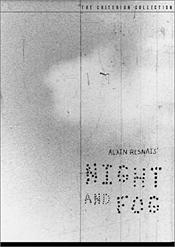"Even a peaceful landscape…even a meadow in harvest, with crows circling overhead and grass fires…even a road where cars and peasants and couples pass…even a resort village with a steeple and country fair…can lead to a concentration camp." So begins the narration of the most devastating documentary film ever made.
 Before Hollywood determined it takes at least three hours to effectively grapple with the Holocaust – a Schindler's List or a Pianist, for example – long before, some four decades and more, there was Alain Renais' 31-minute Night and Fog.
Before Hollywood determined it takes at least three hours to effectively grapple with the Holocaust – a Schindler's List or a Pianist, for example – long before, some four decades and more, there was Alain Renais' 31-minute Night and Fog.
I first saw and was shattered by this remarkable short movie while in college in 1975. I've just seen Night and Fog a second time, because Criterion recently released a new digital restoration of it on DVD. And 28 years later, Renais' film remains for me not only a chilling record of Hitler's "final solution" but the most powerful cinematic indictment of the State I've ever seen.
Night and Fog mixes color photography of the abandoned grounds of Auschwitz and Majdanek, shot just ten years after the 1945 liberation of those Nazi camps, with horrific black-and-white archival images.
"The blood has dried, the tongues have fallen silent," reads the narrator from a script by Mauthausen survivor Jean Cayrol. The camera pans slowly across a deserted camp in vivid, "present-day" color. "The only visitor to the blocks now is the camera," the voice-over continues. "A strange grass covers the paths once trod by inmates. No current runs through the wires. No footstep is heard but our own." Abruptly, the documentary cuts to black-and-white stills and film footage. "1933," the narrator recites dispassionately. "The machine goes into action. A nation must have no discord. No complaints or quarrels."
Indeed, as Night and Fog reveals, the State is a machine. And a murderous one. Its day-to-day operation is simply business as usual. Says the narrator matter-of-factly:
"A concentration camp is built the way a stadium or a hotel is built: with businessmen, estimates, competitive bids, and no doubt a bribe or two. … Architects calmly design the gates meant to be passed through only once. Meanwhile, Burger, a German worker; Stern, a Jewish student in Amsterdam; Schmulski, a merchant in Krakow; and Annette, a schoolgirl in Bordeaux, go about their daily lives, not knowing a place is being prepared for them hundreds of miles away. One day their quarters are ready. All that is missing is them."
We watch the State's victims being herded onto the trains, into the trucks, then into the camps. We see the SS slogans that greet them upon their entry: "Cleanliness is health." "Work is freedom." "To each his due."
We see the cylinders of zyklon gas. We see the emaciated inmates, then their dead bodies, stacked one atop another.
Shortly, we return to the color photography of 1955's "today." The camera tracks quietly over rusted barbed wire, now surrounding collapsed walls. It worms through gates and doorways. It lingers over one building. "A crematorium from the outside can look like a picture postcard," the narrator remarks. "Today tourists have their snapshots taken in front of them." We are drawn inside to study the now-cold ovens that were once so essential in making room for the next trainload of arrivals.
The camera eventually takes us to one of the camps' observation towers, standing watch over the growing debris. The narrator concludes:
"Who among us keeps watch from this strange watchtower to warn of the arrival of our new executioners? Are their faces really different from our own? … With our sincere gaze we survey these ruins, as if the old monster lay crushed forever beneath the rubble. We pretend to take up hope again as the image recedes into the past, as if we were cured once and for all of the scourge of the camps. We pretend it all happened only once, at a given time and place. We turn a blind eye to what surrounds us and a deaf ear to humanity's never-ending cry."
Significantly, Night and Fog never categorizes victims, whether Jew or gypsy or other undesirable. It doesn't identify the executioners by name. It never distinguishes one concentration camp from the other. It doesn't need to. We know that Alain Renais is addressing the Holocaust – specific faces, specific times, specific places. But by speaking in broad language, even while presenting hideous images of the Nazi death camps, Night and Fog widens its message by implication. The State is the State is the State, after all. Some six million died horribly in the Holocaust. But death by the State, suggests Renais' brilliant documentary, is never-ending. At least 100 million people died at the hands of their own governments during the past century.
Never forget.
July 12, 2003
Wally Conger [send him mail] is a marketing consultant and writer living on California's central coast. Five years ago, he visited the Dachau memorial outside Munich and is still shaken by the experience. He has a website, www.WConger.com.




